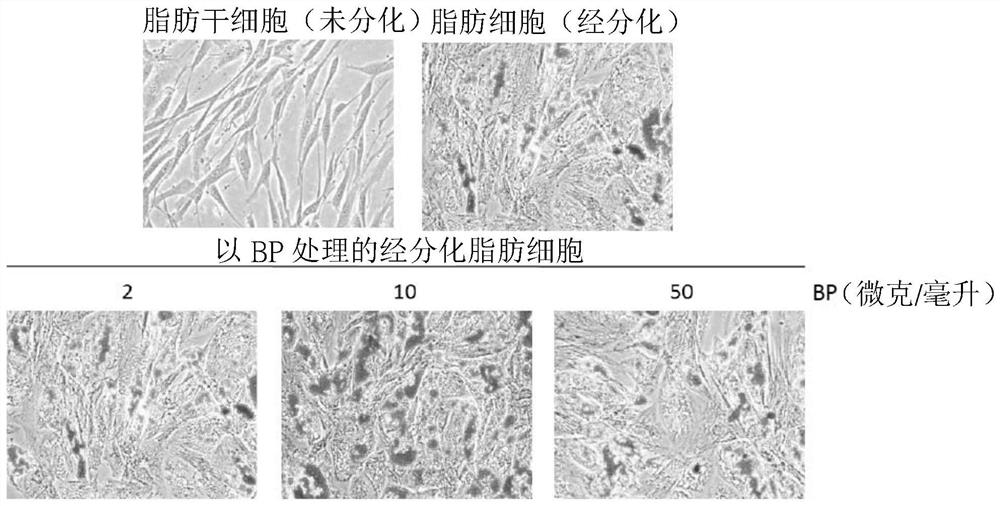Application of Butylenephthalide
A technology of butylene phthalide and purpose, applied in the application field of butylene phthalide, can solve the problems of high cost, lack of technical means, infusion not meeting economic benefits and the like
- Summary
- Abstract
- Description
- Claims
- Application Information
AI Technical Summary
Problems solved by technology
Method used
Image
Examples
Embodiment 1
[0063] Example 1: The effect of butylenephthalide (BP) on promoting the differentiation of stem cells into brown adipocytes
[0064] As mentioned above, unlike white adipocytes, brown adipocytes / brown adipocytes have the characteristics of (i) containing many small fat droplets, (ii) containing a large number of mitochondria, and (iii) highly expressing UCP1 protein in cell morphology . Among them, due to containing a large number of mitochondria, compared with white fat, brown adipocytes / brown adipocytes have a larger oxygen consumption rate and potential respiratory capacity (wherein, potential respiratory capacity refers to the maximum oxygen consumption rate and the basic The difference in oxygen consumption rate represents the amount of oxygen not used to generate ATP). Therefore, by observing the number of small fat droplets in cells, the oxygen consumption rate of adipocytes, and the expression of UCP1 gene and protein, etc., we can understand the amount or ratio of br...
Embodiment 2
[0091] Embodiment 2: observe the situation of the fat browning of mice
[0092] It is known that brown adipocytes contain many small fat droplets. In order to know whether butylenephthalide (BP) has the effect of promoting fat browning in animals, subcutaneous adipose tissue and visceral adipose tissue provided by B2-3 were collected by Formalin-fixed, embedded in paraffin, and sectioned. The aforementioned sections were stained with hematoxylin-eosin stain (hematoxylin-sosin stain, H&E stain) to observe the cell morphology of the adipose tissue of mice in each group, and the results are shown in Figure 5A (subcutaneous fat) and Figure 5B (Visceral fat).
[0093] Depend on Figure 5A and Figure 5B It can be seen that the subcutaneous adipose tissue and visceral adipose tissue of the "HFD" group mice are composed of single and large white adipocytes, while the "HFD+BP" group, "HFD+ADSC" group, "HFD+BP+ADSC" group The subcutaneous adipose tissue and visceral adipose tiss...
Embodiment 3
[0095] Example 3: Appearance of heart, liver, kidney, subcutaneous adipose tissue and visceral adipose tissue of mice
[0096] In order to know whether butylenephthalide (BP) can improve the accumulation of white fat, the appearance photos of the liver, heart, kidney, subcutaneous fat tissue and visceral fat tissue of mice in each group recorded in B2-3 are shown in Figure 6A . The weights of subcutaneous adipose tissue and visceral adipose tissue of each group of mice recorded in B2-3 were averaged, and are shown in Table 1, and Figure 6B , Figure 6C .
[0097] Table 1
[0098] Subcutaneous fat tissue (grams) Visceral adipose tissue (grams) "ND" group 0.22 0.59 "HFD" group 0.42 1.0 "HFD+BP" group 0.24 0.57 "HFD+ADSC" group 0.31 0.62 "HFD+BP+ADSC" group 0.28 0.64 "HFD+BLC" group 0.21 0.54 "HFD+BP+BLC" group 0.20 0.46
[0099] Depend on Figure 6A It can be seen that compared with the "ND" group, the "HF...
PUM
 Login to View More
Login to View More Abstract
Description
Claims
Application Information
 Login to View More
Login to View More - R&D
- Intellectual Property
- Life Sciences
- Materials
- Tech Scout
- Unparalleled Data Quality
- Higher Quality Content
- 60% Fewer Hallucinations
Browse by: Latest US Patents, China's latest patents, Technical Efficacy Thesaurus, Application Domain, Technology Topic, Popular Technical Reports.
© 2025 PatSnap. All rights reserved.Legal|Privacy policy|Modern Slavery Act Transparency Statement|Sitemap|About US| Contact US: help@patsnap.com



